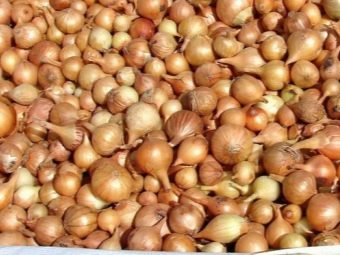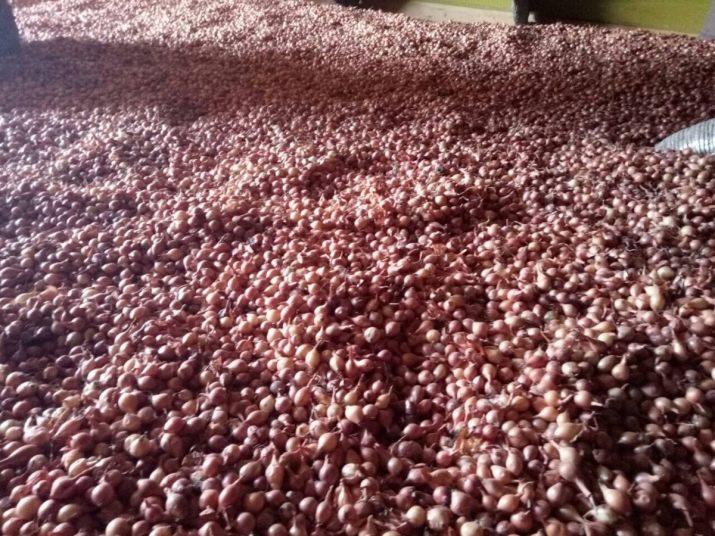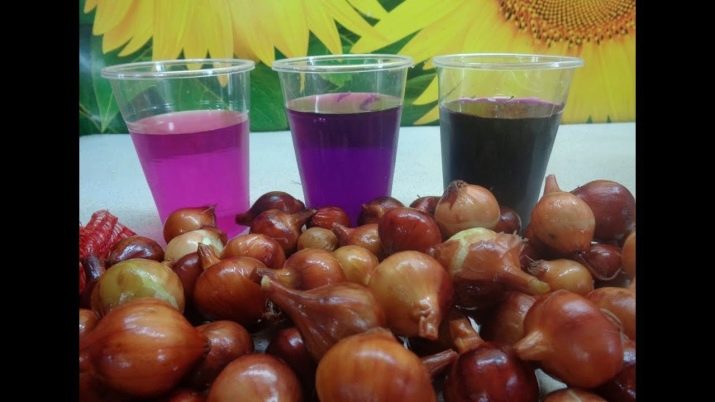Processing onions before planting: the main methods and their features

Many people think that growing onions at home will not be a problem.But in fact, this is not entirely true, but because many novice gardeners face certain troubles when they begin to engage in such an event. The main problem is the bow shooting. It is she who often does not give the opportunity to grow large fruit.
But also the quality of the resulting product is influenced by various diseases that may appear after its landing in the ground and minimize all efforts. Therefore, in order to avoid such problems, it is necessary to plant the plants not only on time, but also properly treat them before planting. If appropriate treatment and disinfection is carried out, it will provide protection not only from diseases, but also allow to get a good harvest.
Characteristics of the procedure
Onions are usually planted in spring. Planted and processed specimens must be planted in the ground, and therefore their preplant preparation is carried out. The need for treatment is to protect the bulbs from diseases and different varieties of pests. Experienced gardeners know the means that are used to prevent such troubles, as well as allow you to get good yields.
In any case, it is important to properly process the material before planting, especially when it was bought on the market, and there is no certainty of its quality. In this case, the processing must be done necessarily.
This procedure will help to achieve these goals:
- accelerate the growth of the bulb and feather;
- increase plant germination;
- increase yields;
- protect against disease;
- protect against pests;
- reduce marksmanship;
- prevent rotting.
Such work is done in the spring just before planting the product in the ground. If all the procedures are carried out correctly, then this will help to get a good harvest not only to experienced gardeners, but also to beginners, who can subsequently enjoy a tasty vegetable, distinguished by its ecological compatibility and qualities of taste.
When planting, it is also necessary to take into account the period of the process, especially if the plant is located on the open ground.
Among such moments are the following:
- landing time - the end of April, as the plant can not be planted in the cold ground;
- the process should not be tightened and should be carried out when the soil warms up by 7-9 cm;
- ambient air temperature should be at least +10 degrees, but if there is no such indicator, then no landing is necessary.
And it is also important to pay attention to the bulbs themselves, namely: to trim them. If the plantation is large, it will be difficult to cut all the bulbs because of their large number. However, it is necessary to remove all the tops from them, which will accelerate the ripening of the fruit and its germination.
With proper pruning, the soaking procedure will also be more effective, since the solution will penetrate inside the bulbs and soak all parts of them. This will avoid unpleasant surprises after planting the plant in the ground. When pruning should pay attention to a fragment of the top. It is not necessary to cut it off much, as this may cause rotting of the material, which will not allow it to let green shoots.
At the preparation stage it is also important to dry the onions, revise them and discard damaged and dried ones.
Sorted raw materials are dried in the sun in a place where there are no drafts. Optimally suited for this loft, window sills and other places.
To awaken the processes in the bulb, it is desirable to heat up at a temperature of +20 degrees. Due to this, germination is activated inside it, and less arrows will emerge after emergence. If there is no time to produce a full warm-up, then on the eve of the landing, the raw material is poured with hot water for 10 minutes, and then immediately cooled, and then landed.
In the northern regions of the country, hardening of onions is also carried out before planting. For this, sevok is sorted, placed in a box and stored in a cellar or placed in a refrigerator where the temperature reaches +8 degrees. It is necessary to take into account that there were no temperature drops. In such a place, the bulbs should stand for 10 days, after which they are placed in heat.
Varieties
To speed up the energy for germination, it is recommended to soak for at least 10 hours before sowing, using special solutions based on fertilizers. After that, an onion is planted in a heated bed.
It is important to decontaminate the beds to improve the quality of the soil. Presowing preparation is made from various pests, for example, from a fly, from a bolt, from a pest or from a fungus. At the end of the treatment, the onions are washed with running water.
After the procedure, seedlings are planted in the prepared beds. At first small sevok landed, and then large. They are closed with earth, and then they are mulched in order to keep heat and moisture in the earth. And also the mulch will save time for weeding and watering.
This will be followed by regular care of the plant, its loosening and feeding. The listed agrotechnical measures are not so laborious, but they require attention from the gardener. As a result, the gardener will get a good harvest.
From bolting
In order to avoid the arrows, pre-heating of the raw material is applied before it is landed. This can be done on the radiator or in the attic. Seeds wake up on cardboard and treated with rays.
During the first two weeks of warming up you should stick to +20 degrees. Then for 10 hours the degree rises to +45. At the moment it is important to look in order not to hold the material more than the allotted time.
After that, it is recommended to harden the material and accustom it to the temperature changes that will affect after it has landed in open soil. To do this, water is heated to +45 and onions are placed in it for 10-15 minutes. Then the material is placed immediately in cold water for the same time. Then he laid out on cardboard, dried and planted.
From pests
Sevok can be processed in various ways, which are quite a lot. Experienced gardeners cannot name the only method that will be the most effective and will be able to simultaneously protect planting material from diseases and pests. It is important to prepare the material by selecting high-quality bulbs, then sanitizing the soil, and also cutting the sevok. This will help to increase the resistance of the material to the effects of pathogenic flora. But it is also important to determine the size of the bulbs before planting. This will help simplify their care in the future.
In any case, gardeners recommend planting only your onions in the garden, as well as those purchased from a trusted seller, and not on the market, as it is not always possible to visually determine the quality of the raw materials and the presence of spores or various diseases in it.
If it is not possible to find such seedlings, then it will be necessary to carry out the procedure of disinfection of the purchased material without fail. Today there are many drugs that do well in this task. All of them have their disadvantages and advantages, and therefore they should be known before use.
Usually use the most proven and effective way - soaking materials in a solution of potassium permanganate for 20 minutes. Some owners add another 1-2 grams of nitrate to the solution. Salt will help increase the resistance of the material to pests and bacteria. To do this, it must be diluted in 10 liters of water 5-6 mg, and then placed there for 5 minutes sevok.
The same solution, but with a lower concentration, can be poured onto the bed before planting the material in order to disinfect the soil. Do not take a lot of salt and pour it on the soil. This may protect the plant from diseases, but will ruin the land itself, and therefore the procedure should be a one-time.
If necessary, you can purchase special drugs in stores, among which is “Fitosporin”.It is diluted in a bucket of water, then the bulbs are immersed there for 10-20 minutes. After soaking the water can be poured on the garden bed. When soaking, it is important to follow the instructions on each package.
From fungus
To get a big harvest, you need to know that all crops, including onions, are exposed to diseases. They trap them not only in the ground, but also at the time of storage. This has a negative effect on the quality of the crop. In some cases, sevok completely dies. To avoid this, you need to know which parasites to fight, and which of them represent the greatest danger to the culture. This will help to understand what kind of processing is needed bulbs.
Among them are several pests.
- Mealy dew. The disease is determined by light spots on the bulb, which later turn purple. With this disease, feathers dry out after appearance. The causative agent of pathology overwinters in the bulb itself and does not give out its presence until it is transferred to the ground and the first shoots appear, after which the oppression of the plant begins.
- Ball Rot Pathology is common and appears when the material is not properly stored in winter.
- Cercospora Recognized pathology on the heels of a brown color. They are on the feathers of the bow. Pathology begins to develop during the growing season and does not allow leaves to form. The infection persists in the bulb for a long time.
- Rust. A characteristic manifestation of this disease are bulging pads, which then become a dark shade. It also contributes to the drying of feathers and adversely affects the yield.
- Onion moth. It lives inside feathers, it develops there, and as a result, the upper part of the bow dries out.
- Scoop. Infection occurs in May, when large shoots appear on the plant and the parasite eats them.
- The beetle is an undercover. Recognized by the cavities on the feathers, which are a sign of his presence. The larva consumes the pulp of arrows and eats stripes there. At the same time, there are gaps on the body of the arrow. This parasite also reduces the ability of plants to grow well.
Effective methods
Plant immunity is enhanced by pre-treatment of bulbs before planting. This increases resistance to disease and other parasites. Prevent the occurrence of diseases by soaking.
They process the material by various means, for example, soda, salt, birch tar, potassium permanganate, vitriol, alcohol and others. Disinfection is carried out strictly according to the rules. The solution can be moistened not only onions, but also the ground before sowing. It is also possible to purchase a special component in a store for family use and treat the soil or the bulbs with Fitosporin.
Folk
For disinfection is used most often a solution of potassium permanganate. The consistency should be weak, nevertheless it will remove most of the microorganisms from the bulb, but will not adversely affect the material itself. Usually used medium consistency, which is able to remove mold, fungus and does not harm the bulb. A more concentrated solution is used when the bulb is heavily infected with a fungus. Weak soil can be treated before planting.
Some owners treat the material with salt. It copes with bacteria, but a large concentration negatively affects the bulb itself, and therefore this method requires sufficient experience from gardeners.
But it must also be remembered that it is not recommended to use this tool to disinfect the soil at the landing site, as it will deteriorate and will need to be replaced.
Copper sulphate is also used for effective disinfection. Here it is worth remembering that this tool is toxic, and therefore the work must be carried out carefully.
Professional
Currently, it is possible to apply for disinfection not only folk techniques that are available to everyone, but also chemical products produced in factories. Among these marked drug "Fitosporin", which is in each specialized point of sale. To prepare a solution from it, you need to take 10 liters of water and 40 g of funds. In such a solution is placed onion for 30 minutes, then planted in the ground. Rinse it after this is optional. But we must remember that when planting the soil temperature should not be below +15 degrees.
Useful tips
To get the maximum result from the process, you must first decide for what purposes the crop is planted. Depending on this, the landing component is selected. For example, if onions are grown on a feather, then before planting it is necessary to go through all the processing steps. As a result, the top will be beautiful and smooth.
When onions are planted on chernushka, you need to choose large bulbs that have the distinctive features and characteristics of this variety. If you need to plant onions on a turnip, then select the appropriate large bulbs, which can gain up to 200 grams of weight. And they also differ in a set of vitamins.
We should not overlook and underestimate the importance and necessity of the quality preparation of planting for planting, as well as its processing. Only properly processed material can be the key to a good and bountiful harvest in the future.
On the preparation of onions for planting, see also in the next video.













































